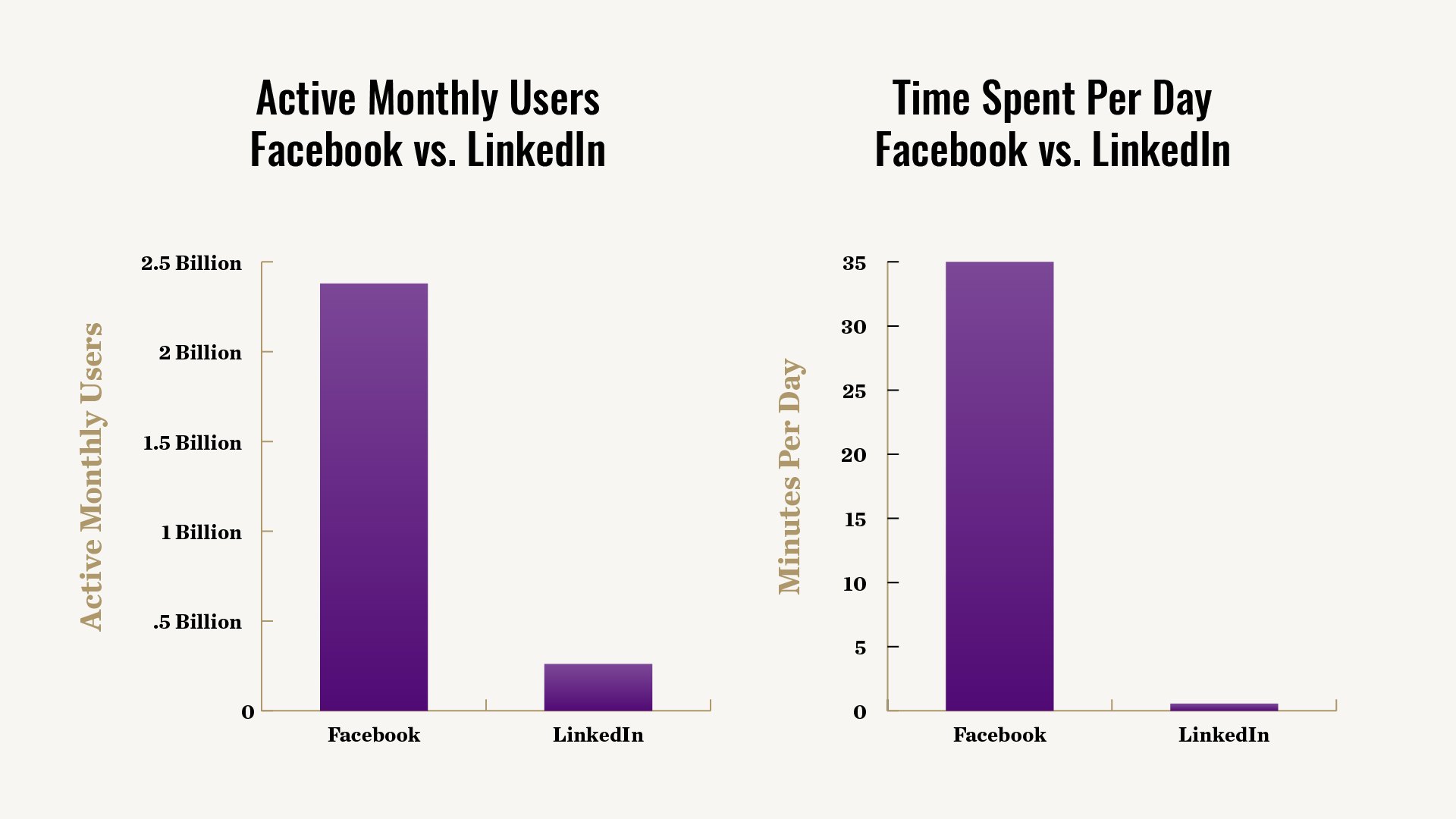LinkedIn is for business. Facebook is for fun. Both are people-based marketing opportunities to reach your audience. So as a B2B marketer, which do you choose?
Your first thought may be to jump on LinkedIn for marketing to prospects (after all, it is the platform for business professionals). But let’s not dismiss Facebook as a real option for B2B companies just yet.
To determine which social media platform is best for B2B businesses, we decided to compare the two for you, looking at everything from cost to technology. Here’s what you need to know when thinking about using Facebook or LinkedIn for your advertising needs, and how it can help inform your marketing strategy.
Shall we?
User Base (or, Who Has More People?)
To start off, let’s look at the sheer number of users on each platform. As of 2019, Facebook has roughly 2.38 billion active users worldwide. On the flip side, LinkedIn has about 260 million active users. But what’s more interesting isn’t how many users each social platform claims, but how much time the users are spending on the platform. For Facebook, it’s about 35 minutes per day, while LinkedIn users spend a mere 17 minutes per month using the product.
Here’s a pretty graph to help visualize that…
Not only does Facebook have a huge user base, but those people are also spending more time engaged on the platform. So in this category, there’s really no argument which platform comes out on top.
Winner: Facebook
Paid Social Cost (or, Let’s Talk Money)
Typically, you’ll get more bang for your buck with Facebook. Why? Simply put: there are more people on the platform who are scrolling for longer periods of time (see the above graph). More extensive user base + more time spent on the platform = more affordable ads, as Facebook can show more ads to each user while keeping a reasonable ad to user post ratio.
Now, this isn’t always the case. But we’ve found that even if you’re targeting a similar audience on both LinkedIn and Facebook, the latter often has a lower CPC. This might not be a problem if you’re selling something that costs thousands of dollars (what’s a $100 CPL if that person turns into a $500,000 client?), but if your product or service is lower in cost, Facebook is probably a more affordable option. You might just have to get creative with how you set up the campaign.
Winner: Facebook
Targeting Options and Lead Quality
Any smart marketer knows that just because generating leads is cheaper through one channel, that doesn’t necessarily make it better (especially if you’re selling some expensive stuff). To illustrate that point, if Facebook is typically the cheaper option, why even bother with LinkedIn?
To a degree, both social platforms are based on user input—things you say about yourself. And because people use LinkedIn and Facebook for different reasons (professional vs. personal), things like job titles and employers tend to be more up-to-date and accurate on LinkedIn than on Facebook (B2B targeting technically exists on Facebook, even if it is just a subset of a larger option). Additionally, Facebook has removed a number of business-related targeting features—education, employment, field of study, and job title are gone, as is access to information about spending habits, home ownership, and investments, as well as third-party commercial suppliers. You’re more likely to find active, business-focused groups to target on LinkedIn as well. Add in the fact that a user might be more willing to click on a “business” ad on a “business” platform, and LinkedIn looks pretty attractive to the B2B marketer.
But don’t be fooled. If your target audience is on LinkedIn, they’re probably on Facebook, too. They just might be harder to find. If you’re still looking for a particular audience on LinkedIn, you might just have to try a different strategy to find them on Facebook. For example, to find those “UX designers” on Facebook you could try targeting people interested in web design.
All that said, lead quality for B2B business tends to be better on LinkedIn.
Winner: LinkedIn
Ad Types
If you’re looking for variety, Facebook has a lot to choose from, including Canvas, carousel, video, dynamic, and lead ads, to name a few (see below image). However, between 2018 and 2019, LinkedIn has continually improved its ad experience. Video, carousel, and lead ads are all now available, as well as Sponsored InMail content and display/text ads.
One of the most substantial developments for LinkedIn has been their mobile-optimized lead ads. 80% of LinkedIn’s user base is mobile users, and they have optimized the lead ad experience to be more mobile-friendly. These improved forms take fewer steps to convert and have the potential to go to your website and convert on another piece of content through a “visit website” button.
With those updates in mind, Facebook is valuable to paid media advertisers because everyone uses it. LinkedIn’s user base is much smaller than Facebook’s, but their cost combined with the amount of profession-based targeting information available increases the likelihood that this will be the preferred channel for B2B marketers.
Winner: LinkedIn
Ad Technology
When it comes to ad technology, Facebook has LinkedIn beat (for now, at least). Part of this is probably because Facebook is pretty massive, and therefore has tons of data. They also leverage a lot of clickstream data and constantly tag your interests based on your activity. That means you don’t actually have to tell Facebook you’re interested in celebrity gossip—if you click on it, they’ll know.
But while Facebook has been largely the innovator in social media ad technology, LinkedIn has been making up ground, starting with launching new audience networks and matched audience targeting in 2017 (thanks, Microsoft). They have also implemented lookalike audiences and interest-based targeting as of late 2018 and early 2019, which has thrust them forward into being more competitive in the B2B space. Time will tell how much more viable these improvements will make them against ad competitors, so as of right now we will still give the edge to Facebook.
Winner: Facebook
So Who’s the Winner? That’s for You to Figure Out
So which is actually best for your product? Well, that all depends (see above). If you’re simply glancing over the categories, it looks like Facebook is the winner. If what you care about most is accessing a large user base, lead quantity, and reduced CPL, then Facebook might be the way to go. However, if you are more focused on lead quality, concentrated B2B targeting, and B2B optimized ad types, then LinkedIn is the better option.
Choosing a channel is only half the battle. With tons of options and data available to marketers, we need to remember that we, in fact, still must deliver a compelling offer. No matter how great the targeting, you’re never going to drive leads, increase revenue, grow your user base, or achieve whatever your goal may be by merely pushing subpar offers to your target audience.
In the end, social media advertising gives us the tools to reach people in a way we’ve never been able to before. Now you just have to figure out which channel is best for your campaign (and choosing both isn’t cheating either).






